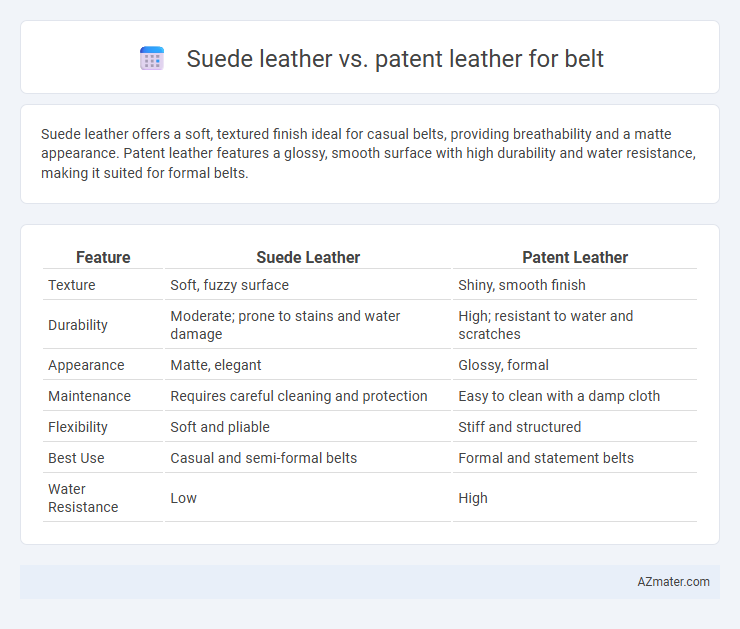Suede leather offers a soft, textured finish ideal for casual belts, providing breathability and a matte appearance. Patent leather features a glossy, smooth surface with high durability and water resistance, making it suited for formal belts.
Table of Comparison
| Feature | Suede Leather | Patent Leather |
|---|---|---|
| Texture | Soft, fuzzy surface | Shiny, smooth finish |
| Durability | Moderate; prone to stains and water damage | High; resistant to water and scratches |
| Appearance | Matte, elegant | Glossy, formal |
| Maintenance | Requires careful cleaning and protection | Easy to clean with a damp cloth |
| Flexibility | Soft and pliable | Stiff and structured |
| Best Use | Casual and semi-formal belts | Formal and statement belts |
| Water Resistance | Low | High |
Introduction to Suede and Patent Leather
Suede leather, known for its soft, napped texture, is created by sanding the inner surface of animal hides, offering a matte finish ideal for casual and stylish belts. Patent leather features a high-gloss, shiny surface achieved through a coating process that enhances durability and water resistance, making it suitable for formal belts. Both leather types provide distinct aesthetics and textures, catering to different fashion needs and occasions.
Origins and Manufacturing Processes
Suede leather originates from the underside of animal hides, primarily lamb, goat, or calf, creating a soft, fuzzy texture through a buffing or sanding process, making it ideal for belts requiring a matte, velvety finish. Patent leather is crafted by applying a high-gloss coating, typically polyurethane or acrylic, over a smooth grain leather base, resulting in a shiny, reflective surface achieved through a specialized finishing technique invented in the 19th century. The manufacturing process differences impact durability and appearance, with suede belts offering breathability and flexibility, while patent leather belts deliver water resistance and a polished look.
Texture and Appearance Differences
Suede leather features a soft, napped texture created by buffing the inner layer of the hide, resulting in a matte finish that offers a casual and luxurious look ideal for belts. Patent leather has a smooth, glossy surface achieved through a high-gloss coating process, giving belts a shiny, polished appearance perfect for formal wear. The tactile contrast between suede's velvety feel and patent leather's slick, reflective finish distinctly impacts the aesthetic and style versatility of belts.
Durability and Longevity
Suede leather offers a soft, textured finish but is less durable and more prone to wear and stains compared to patent leather, which features a glossy, coated surface resistant to water and scratches. Patent leather's protective layer enhances longevity, making it ideal for belts subjected to frequent use and exposure to elements. Both materials require proper care, yet patent leather belts generally maintain their appearance and structural integrity longer than suede belts.
Comfort and Flexibility Comparison
Suede leather belts offer superior comfort due to their soft, napped texture that molds easily to the body's shape, reducing stiffness and irritation. Patent leather belts, with their glossy and rigid finish, tend to be less flexible, often feeling stiffer and less breathable. For prolonged wear, suede provides enhanced flexibility and comfort, making it ideal for all-day use.
Maintenance and Care Requirements
Suede leather belts require regular brushing with a suede brush to remove dirt and maintain their soft texture while avoiding water exposure to prevent stains. Patent leather belts need frequent wiping with a damp cloth and polishing with a leather conditioner to preserve their glossy finish and prevent cracking. Both types benefit from proper storage in a cool, dry place away from direct sunlight to extend their lifespan.
Style Versatility: Formal vs Casual
Suede leather belts offer a soft texture and matte finish that complement casual and smart-casual outfits, making them ideal for relaxed settings or daytime wear. Patent leather belts feature a glossy, polished surface that enhances formal attire, providing a sleek and sophisticated look suitable for business or evening events. Choosing between suede and patent leather belts depends on the desired style versatility, with suede leaning towards casual elegance and patent leather emphasizing classic formality.
Weather and Environmental Suitability
Suede leather belts excel in dry, cool weather conditions due to their soft texture and breathability but are prone to damage from moisture and stains, making them less suitable for wet or humid environments. Patent leather belts offer a glossy, polished finish that resists water and dirt, making them ideal for damp or rainy climates and easier to maintain in harsh environmental conditions. Choosing between suede and patent leather belts depends on balancing aesthetic preferences with the typical weather exposure and care requirements.
Price Point and Value for Money
Suede leather belts typically offer a more affordable price point compared to patent leather due to the less intensive finishing process and the use of softer, napped leather. Patent leather belts, with their glossy, polished surface, tend to be priced higher, reflecting the added manufacturing steps and luxurious appearance. When considering value for money, suede provides a durable yet stylish option for casual wear, while patent leather commands a premium for formal occasions, offering long-lasting shine and crisp aesthetics.
Choosing the Right Leather for Your Belt
Suede leather offers a soft, textured finish ideal for casual or vintage-style belts, providing breathability and a matte appearance that ages gracefully. Patent leather, recognized for its glossy, high-shine surface, delivers a sleek and formal look suitable for dress belts, emphasizing durability and easy cleaning. Selecting the right leather depends on your wardrobe needs and occasions, with suede enhancing relaxed outfits and patent leather elevating formal attire.

Infographic: Suede leather vs Patent leather for Belt
 azmater.com
azmater.com